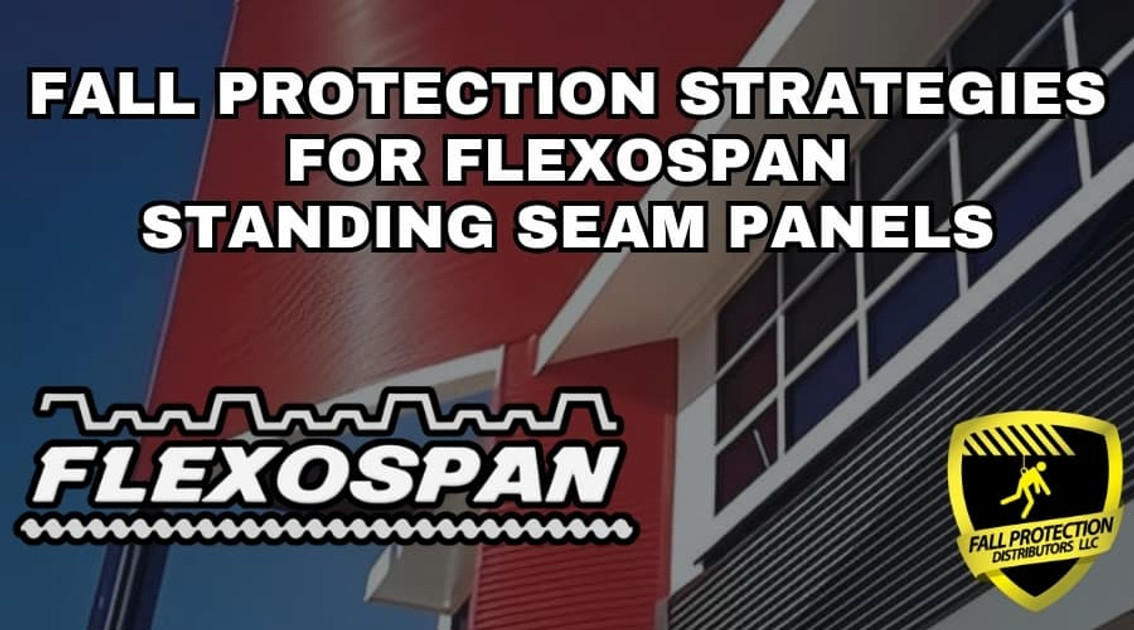Fall Protection Strategies For Flexospan Standing Seam Roofs
Posted by Howie Scarboro - CEO Fall Protection Distributors, LLC on Nov 18th 2025
See the Roof Anchor Compatibility Chart for Flexospan Steel Buildings Standing Seam Panels.

Who Is Flexospan Steel Buildings?
Flexospan builds premium pre-engineered buildings and standing seam metal roof systems backed by more than 50 years of manufacturing experience and panel innovation.
Flexospan Steel Buildings, Inc., headquartered in Sandy Lake, Pennsylvania, has remained a trusted name in the metal building and panel manufacturing industry since 1969. The company delivers roofing, siding, structural components, trims, purlins, and complete self-storage systems for commercial and industrial projects across North America.
Their 265,000-square-foot production facility maintains a large coil inventory, including galvanized steel, Galvalume Plus, stainless steel, bare aluminum, and painted steel, available in multiple finishes and more than 15 standard colors. With over 20 standing seam and exposed-fastener panel profiles, the company serves a wide range of roofing, siding, and structural applications while supporting custom builds that require nonstandard gauges or finishes.
Flexospan's engineering team contributes decades of real-world project experience, helping the company design standing seam roof systems that combine durability, proven weather performance, and long-term value for building owners.
What Is The Best Fall Protection For Flexospan Standing Seam Roofs?
Working safely on Flexospan standing seam roofs requires fall protection that grips the seams securely without penetrating the metal.
These panel systems rely on hidden clips and thermal expansion to remain weather-tight, and even a single penetration can cause water leaks, panel deformations, and voided warranty coverage. The safest approach uses non-penetrating fall protection solutions that match the panel material gauge, seam shape, and slope of each Flexospan profile.
For non-curved 22-gauge and 24-gauge steel Flexospan panels, the SSRA1 Standing Seam Roof Anchor attaches directly to the seam using twelve stainless-steel set screws rather than through-fasteners. This attachment method preserves panel integrity while providing a certified tie-off point for contractors and maintenance crews.
When workers need a level work surface, a pair of SSRA2 Adjustable Roof Jack Adapters mounts on top of two SSRA1 anchors to support ten-foot walk boards. This assembly provides installers with a stable platform for working on steep metal roofs. The SSRA2 Roof Jacks Adapters are adjustable for various seam heights and roof pitches.
For projects that require continuous tie-off while working on larger Flexospan roofs, SSRA3 Anchor Plates transform the system into a temporary horizontal lifeline mount. The aluminum SSRA3 Anchor Plates are a key part of the SSRA HLL 100-Foot Temporary Horizontal Lifeline Kit, which includes four SSRA1 anchors, two SSRA3 plates, and the Malta Dynamics HLL3001 system. The setup supports two workers and provides non-penetrating lifeline protection after just a few minutes of installation time.
Facilities that require routine worker access can benefit from installing the Super Anchor 120-foot Permanent Horizontal Lifeline Kit, which stays mounted year-round, eliminating the need for repeated setup time while providing safe, OSHA-compliant tie-off points for maintenance teams. Workers save time by having a horizontal lifeline in place to protect them on each trip up to the roof.
On roof pitches from 6:12 to 12:12, workers can also use the Ridge Pro Steep Assist Anchor, which hooks over the ridge and allows the worker to connect to a secured vertical lifeline before stepping onto the standing seam surface. This approach doesn't rely on seam attachment, yet still provides worker tie-off from ladder to ridge and back again.
FSS-1.5 Mechanical Panel

The FSS-1.5 panel offers an architectural profile with multiple widths and a 1.5-inch seam for flexible design use.
Flexospan's FSS-1.5 panel serves as a versatile architectural standing seam option for projects that demand clean lines, smooth transitions, and varied roof elevations. The profile uses a flat pan and a 1.5-inch seam, giving designers a modern visual style. Installers can apply it over solid decking, which makes the profile a smart match for residential upgrades and light commercial roofing. See the Roof Anchor Compatibility Chart for Flexospan Steel Buildings FSS-1.5 Standing Seam Panels.
Buyers can select 12-inch, 16-inch, 20-inch, or 24-inch coverage widths depending on desired appearance, panel spacing, and overall budget. The 20-inch width is most widely used in the field because it features stiffening ribs and offers the lowest material cost per square foot. Flexospan rolls this profile in 22-gauge and 24-gauge steel as well as aluminum, giving architects and contractors numerous finish options.
Fall Protection for FSS-1.5 Panels
Steel FSS-1.5 panels support non-penetrating seam anchors, while aluminum installations require ridge-based tie-off planning.
For 22-gauge and 24-gauge steel FSS-1.5 panels, crews can work safely using non-penetrating seam anchors that lock onto the seam without interfering with the concealed clip system. The SSRA1 Standing Seam Roof Anchor attaches using 12 stainless-steel set screws instead of roof fasteners, providing a certified tie-off point without penetrating the metal.
When installers need a level work surface on steep metal roofs, a pair of SSRA2 Adjustable Roof Jack Adapters mounts on two SSRA1 anchors to support a 10-foot walk board. Each adapter adjusts for roof pitch and seam height, keeping the working surface level while reducing slip risk.
Projects that require more worker mobility across larger roof areas can add SSRA3 Anchor Plates above the SSRA1 anchors, creating the mounting points needed for a temporary horizontal lifeline. These aluminum plates are part of the SSRA HLL 100-Foot Temporary Horizontal Lifeline Kit, which supports two workers while maintaining a fully non-penetrating anchorage system.
For aluminum FSS-1.5 panels, workers should avoid using seam-mounted systems. For those panels, the best method would be the Ridge Pro Steep Assist Anchor on slopes from 6:12 to 12:12, allowing workers to connect to a locked vertical lifeline before stepping onto the metal surface.
FSS-18 Mechanical Panel
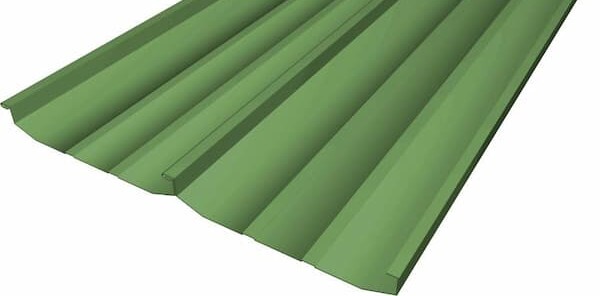
The FSS-18 profile delivers superior strength with a taller seam height and an 18-inch coverage width for structural projects.
Flexospan's FSS-18 panel suits new construction and retrofit roofing where long, open purlin spans or wide building bays require added rigidity. The panel is 18 inches wide with a 2⅝-inch-tall seam, creating a stronger vertical rib than lighter architectural profiles. Flexospan rolls this panel in 22-gauge or 24-gauge steel, with a separate aluminum option available when weight reduction or corrosion resistance is a primary concern. Steel selections include G-90 galvanized, Galvalume, stainless, and painted finishes in a wide range of colors. Factory-formed stiffening ribs come standard, helping the profile resist distortion on long runs or negative-pressure roof zones. UL-90 uplift testing ensures performance in strong wind environments. See the Roof Anchor Compatibility Chart for Flexospan Steel Buildings FSS-18 Standing Seam Panels.
Fall Protection for FSS-18 Panels
Steel FSS-18 roofs support seam-mounted anchors, while aluminum installations rely on ridge-based tie-off solutions.
On 22-gauge and 24-gauge steel FSS-18 projects, the SSRA1 Standing Seam Roof Anchor provides a non-penetrating tie-off point with 12 stainless-steel set screws that lock onto the seam at low torque.
When crews need a level working surface on steep roofs, two SSRA2 Adjustable Roof Jack Adapters can mount to SSRA1 anchors, allowing a 10-foot walkboard to remain level on most standing-seam roofs. Adjustability for pitch and seam height helps reduce worker fatigue and slip risk on steep roof areas.
For roofs requiring increased worker mobility across large roof areas, SSRA3 Anchor Plates mount to SSRA1 anchors to serve as anchor points for temporary horizontal lifelines. These aluminum plates are part of the SSRA HLL 100-Foot Temporary Horizontal Lifeline Kit, supporting two workers while maintaining fully non-penetrating anchorage across the steel seams.
Aluminum FSS-18 panels are not compatible with seam-mounted systems. For those installations, crews can instead use the Ridge Pro Steep Assist Anchor on roof pitches from 6:12 to 12:12, allowing workers to connect to a secured vertical lifeline before stepping onto the metal surface and eliminating all seam contact.
FSS-316 Mechanical Panel
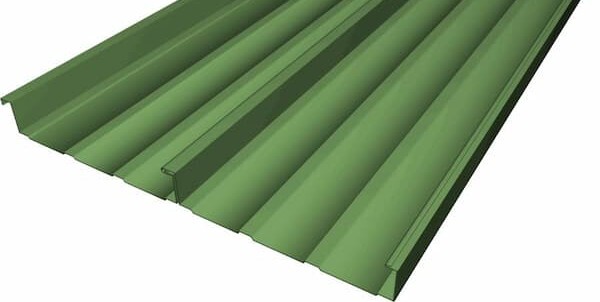
The FSS-316 profile uses a tall 3-inch seam and a 16-inch coverage width for clean transitions and architectural alignment.
Flexospan's FSS-316 standing seam profile features a straight-sided rib rather than a trapezoidal seam, helping installers flash terminations, valleys, and step details more efficiently on commercial and light-industrial structures. The panel width is 16 inches, while the 3-inch vertical rib adds visual depth and keeps the seam elevated above slow-draining zones. Flexospan manufactures this panel in 22-gauge or 24-gauge steel, and aluminum is available when a lighter, corrosion-resistant option fits the design or exposure environment. See the Roof Anchor Compatibility Chart for Flexospan Steel Buildings FSS-316 Standing Seam Panels.
Fall Protection for FSS-316 Panels
Steel FSS-316 roofs accept seam-mounted anchors, while aluminum installations shift to ridge-based tie-off methods.
For 22- or 24-gauge steel FSS-316 panels, workers can attach to the seam using non-penetrating anchors rather than fasteners. The SSRA1 Standing Seam Roof Anchor locks to the rib using 12 stainless-steel set screws at low torque, providing a certified tie-off point without breaching the panel or altering the concealed clip system.
Installers can mount SSRA2 Adjustable Roof Jack Adapters to two SSRA1 anchors, allowing a 10-foot walkboard to sit level across steep metal panels. Each adapter adjusts for seam height and roof slope, accommodating most standing seam roof systems.
When mobility across larger roofs becomes necessary, crews can add SSRA3 Anchor Plates onto SSRA1 anchors to create anchor points for temporary horizontal lifeline setups. These plates integrate into the SSRA HLL 100-Foot Temporary Horizontal Lifeline Kit, which supports two workers at a time.
Aluminum versions of the FSS-316 panel are not compatible with seam-mounted anchors. For those installations, crews can use the Ridge Pro Steep Assist Anchor on slopes from 6:12 to 12:12. This ridge-based approach allows the worker to clip into a secured vertical lifeline before stepping onto the metal surface while avoiding seam attachment.
Standing Seam Metal Roof Anchor Panel Compatibility Chart For Flexospan Steel Buildings
| FSS-1.5 24 Ga. | FSS-1.5 22 Ga. | FSS-18 24 ga. | FSS-18 22 ga. | FSS-316 24 Gauge | FSS-316 22 Gauge | |
|---|---|---|---|---|---|---|
SSRA 1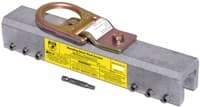 |
NO | YES | NO | YES | NO | YES |
SSRA1 Nylon Tip |
YES | YES | YES | YES | YES | YES |
SSRA2 Roof Jack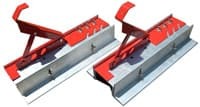 |
YES | YES | YES | YES | YES | YES |
SSRA3 Anchor Plate |
YES | YES | YES | YES | YES | YES |
The Ridge Pro |
YES | YES | YES | YES | YES | YES |
>
Contact Us for Expert Standing Seam Fall Protection Advice
For expert guidance on standing seam roof anchors, lifeline kits, and fall protection systems that protect both your crew and your panels, contact us today at 863-703-4522 or visit www.StandingSeamRoofAnchor.com. Our safety specialists can help you match the right non-penetrating anchor to your specific roof profile and slope. Let's make your next metal roofing project safe, compliant, and built to last. For continued learning, download OSHA's 48-page Fall Protection Manual and our free Anchor Inspection Form once you've selected the ideal anchors for your roof system. Together, we'll help you stay ahead of OSHA standards while preserving your roof's weather-tight seal.
Safety Tips For Standing Seam Roofs
Equip Workers With High-Quality Personal Fall Protection Gear
Crews who work on Flexospan standing seam roofs need equipment that feels dependable the moment they clip in. A properly sized full-body harness, a smooth-braking SRL like the Malta Dynamics Pygmy Hog or Edgehog series, and hardware checked at the start of every shift builds confidence before anyone leaves the ladder. Make sure workers understand how to adjust leg straps, chest straps, and dorsal positioning since OSHA continues to push for improved fit and inspection habits across all trades.
Use Seam-Compatible, Non-Penetrating Anchors Only
Flexospan's roof systems rely on hidden mounting clips, so anchors must grip the seam without penetrations. The SSRA1 Standing Seam Roof Anchor attaches with stainless steel set screws at low torque, which prevents seam distortion. Avoid anchors that require fasteners driven into the panel or that require guessing about clip locations on existing metal roofs.
Install Permanent Horizontal Lifelines on Buildings With Recurring Access Needs
Facilities with Flexospan roofs often host maintenance crews for HVAC service, solar equipment checks, camera systems, or skylight repairs. The Super Anchor 120-foot Permanent Horizontal Lifeline Kit gives long-term tie-off access without forcing workers to install temporary anchors each time they return. This type of permanent setup increases compliance and reduces time on the roof while preserving the integrity of Flexospan panels.
Promote a Safety Mindset Every Single Morning
A quick briefing before stepping onto the roof keeps the entire crew aligned on weather, work sequence, tie-off points, and hazards unique to the Flexospan jobsite. Encourage workers to speak up when something changes mid-shift or if a near-miss occurs. A culture that communicates hazards early is far more valuable than any policy written in a binder.
Use Guardrails and Controlled Access Zones Where Practical
Guardrails remain one of the few fall protection methods that work even when a worker forgets to clip in. On Flexospan roofs with large open spans, skylights, parapets, or roof-mounted equipment, temporary or modular guardrails can reduce exposure and guide worker movement. Guardrails create predictable, safe working zones rather than open areas that invite shortcuts.
Develop OSHA-Compliant Safety Plans Before Work Starts
A safety plan is more than a requirement. It outlines where lifelines will run, how workers will reach the ridge, and who will perform rescue and communication duties. Clear planning removes hesitation during an emergency and keeps the entire crew moving with purpose. Safety Managers should update plans anytime the roof layout, schedule, or weather changes.
Consult a Fall Protection Professional for Curved or Radius-Formed Metal Panels
Some Flexospan applications involve curved roof panels that do not interact the same as traditional non-curved panels under load. These structures deserve expert review before anchors are selected. A qualified safety professional can determine whether seam clamps, ridge-based anchors, or other systems are appropriate to ensure the roof remains undamaged and compliant.
Require Roofing-Grade, Slip-Resistant Footwear With Full Ankle Support
Metal roofing demands safe, non-slip footing. Soft-soled athletic shoes, mud-tread boots, or worn-down work boots increase the risk of slipping. Roofing-specific footwear with a soft rubber sole and adequate ankle support improves traction.
Include Trauma Straps on Every Harness in Service
Stopping the fall is not the final safety checkpoint. Without trauma relief straps, a suspended worker risks circulation loss while awaiting rescue. Trauma straps deploy quickly and allow the user to assume a standing position while suspended, helping maintain blood flow and consciousness. They cost very little, weigh almost nothing, and should be standard gear on every Flexospan project.
Reinforce Ladder Safety Before Anyone Starts To Climb
A surprising number of incidents occur at ground level or during the first climb. Workers must inspect ladders for bent rails, missing feet, and damaged rungs before use. The four-to-one angle rule, three points of contact, and proper tie-off at the landing area are simple habits that prevent needless injuries.
Disclaimer
The views, recommendations, and information presented in this blog are solely those of the author and do not necessarily reflect the opinions or positions of the featured panel manufacturer, its brands, subsidiaries, or parent companies. Customers are strongly encouraged to contact the roof panel manufacturer directly for inquiries regarding fall protection compatibility with their products and to address any potential warranty issues that may arise after installing our products.

